The Story of Us’ told by the world’s raddest blogger
2022 is going to be a year of massive change for me. I’ll be announcing several new initiatives through the year.
Why the change, you may ask? So, I’m constantly tweaking my business model to optimise for the 4Fs.
Optimising for the 4Fs
Once I was lucky enough to have found my Ikigai, I realised that is not a destination but an ongoing journey (more on that in a later post).
And a journey needs a north star.
My north star is the 4F framework. When choosing the direction in which I want to take my work, I’m optimising for:
(Financials+Fun+Fulfilment)/Effort
(Hat tip to Uday Kiran for the acronym!)
With that guiding principle, let’s look at where my work stands and what are the major gaps I perceive.
My current work landscape
I divide my work into two broad buckets:
- Content creation
- Monetisation
Under Content creation, I have:
- Weekly newsletter: ‘Story Rules on Saturday’, in which I share a mix of content related to the world of storytelling. This includes:
- Content recommendations: Books, podcasts, articles, videos
- Original content on the craft of storytelling: Usually How-tos on specific elements of storytelling
- Analysis of good storytelling: Teardowns of recent presentations, speeches etc.
- Cultural stories: Ramayana, Story Housie
- Other original content on how to build your storytelling skills
- Social media
- Podcast
- Conversations with leading storytellers about their craft. I’ve published 12 episodes so far – not a great run rate, but I’m building this as a resource for the long-haul
- E-books
- I’ve published two small ones, primarily as lead magnets for the newsletter
- Videos
- I’ve got a nascent Youtube presence – no immediate plans on building that though
Under Monetisation, I have:
- B2B work: Training and coaching work for Corporate/Institutional clients (95% of total revenue)
- Data Storytelling (About 70% of total)
- Business Storytelling (Around 10%)
- Startups + Social Sector (6%)
- Coaching (4%)
- Other (5%)
- D2C work: Engaging with individuals directly (5% of total)
- CBC on Data Storytelling. Have run two cohorts so far. The first one was with 20 participants in Oct-20. The second was smaller at 10 in Jan-21. I haven’t offered an open cohort after that
- In Sep-21, I also offered the Data Storytelling course as a self-paced option.
The reason for D2C’s share being so low is not because of my lack of interest in the same – I loved doing the cohorts! The low percentage reflects the steady work that comes my way from established corporate relationships… which fills up my time and makes it challenging to find time for D2C work.
I intend to change that in 2022.
I derive a lot of fun and fulfilment working directly with individual learners and I’m working on some really cool new ‘products’ for this audience. Expect some announcements in the subsequent months. Super-stoked about that!
Meanwhile, today I have an announcement regarding the ‘Content Creation’ part of my work.
I am making two changes:
1. ‘Story Rules on Saturday’ will exclusively become a content recommendation newsletter
In the tradition of some of the storied newsletters like ‘Friday Finds‘ by David Perell, ‘3-2-1‘ by James Clear and ‘The Pinkcast‘ by Daniel Pink, I’ll be converting Story Rules on Saturday into a content recommendation email. So far, I’ve been sharing content recommendations only on the first Saturday of every month. Now it would be every Saturday.
There are a few reasons for this change:
- I was reading a lot more to be sharing just a few recommendations every month. I felt that I should have a more frequent cadence of sharing my learning journey.
- This would free up time to create long-form content (see #2)
In the recommendations, apart from books (not all weeks!), podcast episodes, articles and videos, I also plan to add social media posts, quotes and movies (yes!).
This way, when I’m watching Netflix or Youtube, at 11 pm on a weekday, I can tell myself: “It’s all good. You’re doing it for the newsletter.”
2. I’ll write long-form data narratives to be published separately
Till now I’ve been publishing my articles in this newsletter. But doing so, I realised that a week is not enough time to do a proper deep dive into any topic. If I wish to do justice to a topic, I should not have an artificial constraint of having to publish something by the next Saturday!
My inspiration for this is (I shudder to even take his name in the same breath, but here goes): Tim Urban of Wait but Why.
While I’ve known of and enjoyed his work for several years, I recently read one monster post series (which I’ve reviewed below), and was gobsmacked by his deep and clear thinking and his incredibly engaging storytelling ability.
Inspired by Tim’s work, I hope to write 2-3 long-form narratives in 2022. All subscribers to this email newsletter will get my long-form content too.
With that out of the way, let’s start with this week’s content recommendations.
Book
a. ‘The Story of Us’ by Tim Urban
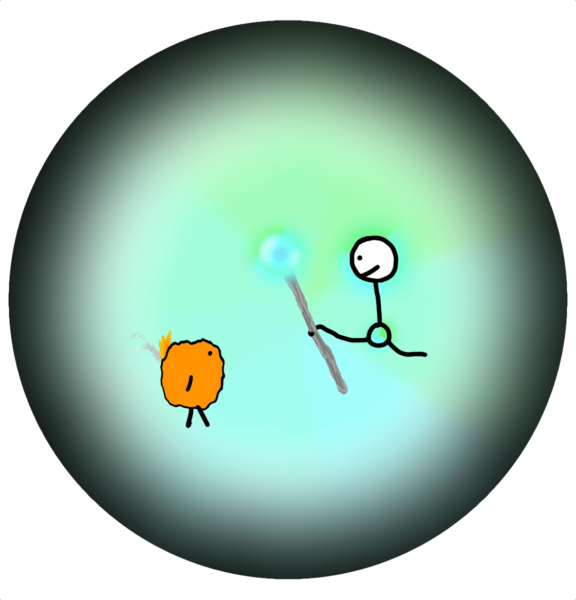
This is technically not a book – it is a series of long-form blog posts. But boy, is it more thought-provoking than several books I’ve read.
You may have come across Tim Urban because of his viral TED Talk ‘Inside the Mind of a Master Procrastinator‘. While the TED talk got him millions of views (59M and counting), his original claim to fame is the blog, ‘Wait but Why‘.
In a world obsessed with tweets, reels, snaps and other short-form content, Tim stands out with his utterly insouciant disregard to our supposedly falling attention spans.
Tim’s posts run into several tens-of-thousands of words (some series are as long as a book). And it’s all there, free to read on his blog!
His strengths are two-fold:
– Tim thinks deep – he’s a modern day philosopher. He grapples with complex topics and gets to the depth of that topic. This itself is a rare skill. But what makes it even more special is that…
– He explains the topic in a simple yet entertaining way. Most philosophers struggle to explain something in simple language. Even if they manage to do that, very few are able to make their writing engaging and fun to read. Tim is a one-of-a-kind genius.
The Story of Us
What I really like about this blog series is that it tackles something critical that affects all of humankind – how the story we tell ourselves about society influences the way we live and interact with each other.
While the series is US-focused and tries to explain why there is such a massive and widening cleavage in the US society, the concepts and frameworks that Tim uses to explain the divergence can be used for any country, including India.
The biggest insight for me was the difference between Primitive Thinking and Higher-Mind thinking. These are simple enough concepts – but the visuals and examples Tim uses do a stellar job of ensuring that you really get it and actually start making changes in your thinking (and actions) based on better awareness.
Here are five storytelling techniques that I enjoyed in this blog series:
1. Foundational depths
Most writers think and write at a superficial level. For instance, consider the question: Why is there so much animosity between Democrats and Republicans in the US today?
Here’s how different thinkers might approach that question:
A staunch Democrat: Because of Trump, duh! And all those illiberal, gun-loving, fascist Reps!
A staunch Republican: Because of these immigration-loving, individual-freedom-hating, weak-willed Commie Dems!
An inexperienced political analyst: It’s all because of how social media amplifies sensationalist events, allows dissemination of fake news and enables echo chambers.
An experienced political analyst: It all started post WW2, which was last the time when Americans of all political affiliation were the most united. The Vietnam War was a major salvo against that unity. In recent history, one major trigger point for things to go south was former Speaker of the House Newt’s Gingrich elevation of partisan politics into an art form.
All good. Detailed, in-depth.
But here’s how Tim Urban would approach that question:
Tim Urban: We need to start with our genes…
“The problem is that the animal world isn’t really an animal world—it’s a world of trillions of strands of genetic information, each one hell-bent on immortality. And in a universe that wants to turn order into chaos whenever possible, the immortality of anything—let alone a delicate and complex genetic code—is a constant uphill battle. Most of Earth’s gene strands don’t last very long, and genes that weren’t talented enough at the immortality game are long gone. The genes on Earth today are the miracle outliers on both the motivation and talent front—such incredible survival specialists that they’re currently almost four billion years old and counting.
Animals are just a hack these outlier genes came up with—temporary containers designed to carry the genes and help them stay immortal. If genes could talk to their animal, they’d probably issue a few simple commands:
(And then he follows up with this visual)
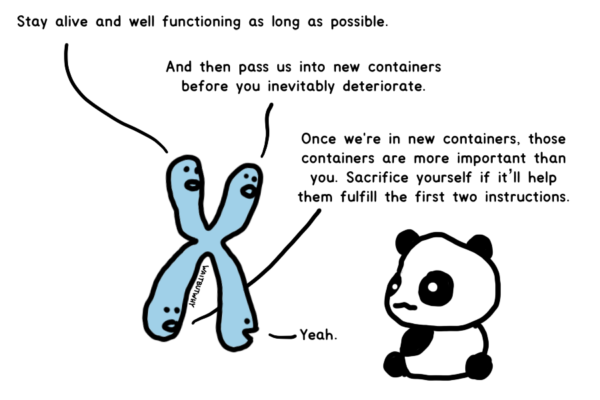
This bedrock thinking – let’s get to the root, the real root of this matter – is what makes Tim such an arresting writer.
2. Visuals
Our brains have a disproportionate amount of capacity devoted to visual processing. Sure your words can evoke visuals in the readers minds… but having vivid explanatory pictures can go a long way in demystifying abstract, complex topics.
Tim gets that. But his genius is to avoid the tried-and-tested route of publicly available image sources like Unsplash or Wikipedia. He just draws his visuals himself. And so you come across funny stick figures and badly drawn pandas, bears and bunnies in between blocks of text. Apart from giving an endearing quality to his posts, they also act as visual relief and add humour.
Take for instance, his depiction of how our genes ‘control’ our actions through a bunch of emotion levers!
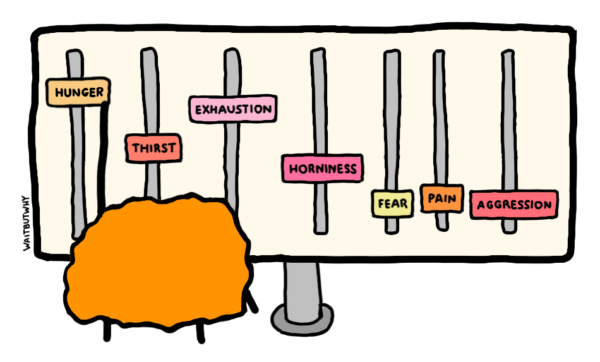
It’s not easy doing this. These visuals take time to create and can become distractions for the writer. Tim has mentioned about how he would get lost in some minor details of a drawing and end up questioning the utility of it all!
But for the reader, it ensures that complex ideas are easily understood.
3. Anthropomorphism
This is my favourite Tim Urban Storytelling technique and I’ve written earlier about it. The way he infuses abstract concepts with human (or animal) characteristics is an art form. We may have heard of the ‘reptilian brain’ or the ‘pre-frontal cortex’ or even brain regions such as amygdala or hippocampus. Instead of using such abstract/scientific terms, Tim converts them into anthropomorphic characters.
In fact, just within the human brain, Tim has created a roster of characters: the fiery Primitive Mind, the wise Higher Mind, the distracted Instant Gratification Monkey, the alarm-raising Panic Monster, the insecure Social Survival Mammoth… Tim has a vivid and fascinating imagination.
4. Historical context
We often wonder why we struggle so much with willpower. Why do we get angry? Why do we see an attack on a closely-held belief as an attack on ourselves?
The answer: Our Primitive Mind – the source of many of our anxieties and emotionally-ridden reactions – has gotten several millennia of experience being in charge of things. Here’s Tim:
The Primitive Mind in every animal—humans included—has been optimized to near perfection at getting animals to survive long enough to pass their precious genes along to new containers.
Scientists aren’t positive about the timeline, but many believe that all humans in all parts of the world lived in hunter-gatherer tribes as recently as 11,000 BC. So 13,000 years ago—or, if we call a generation 25 years, about 500 generations ago.
500 generations isn’t enough time for evolution to take a shit. So the Primitive Mind—a hardwired part of us—is still stuck in the world of 11,000 BC. Which means we’re all like computers running on the highly unimpressive Windows 11000 BC operating system, and there’s no way to do a software update.
(And then he has this striking visual to accompany that):
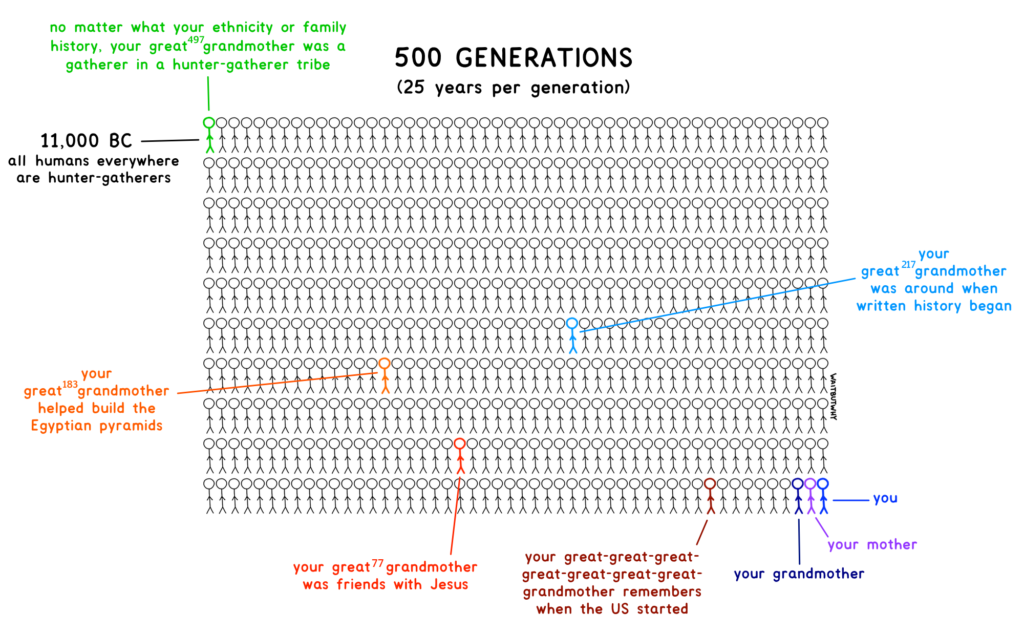
5. Concrete examples
We are aware of a lot of things in theory – but sometimes we need a real concrete example to explain how the theory works.
For instance, Tim is trying to explain how we are in a constant state of battle between the Primitive Mind and The Higher Mind within our brain. He could talk about the concept in abstraction for eons, but it wouldn’t be as effective (or hilarious) as this cartoon strip… (The fiery blob in the cartoon is the Primitive Mind and the wise sounding guy with a glowing staff is the Higher Mind):


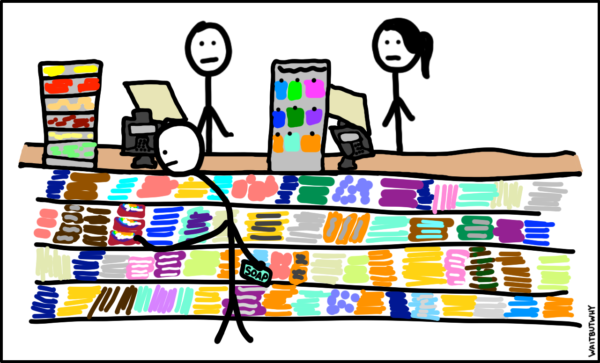
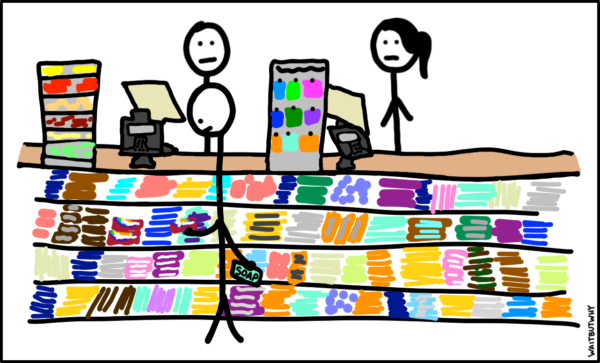
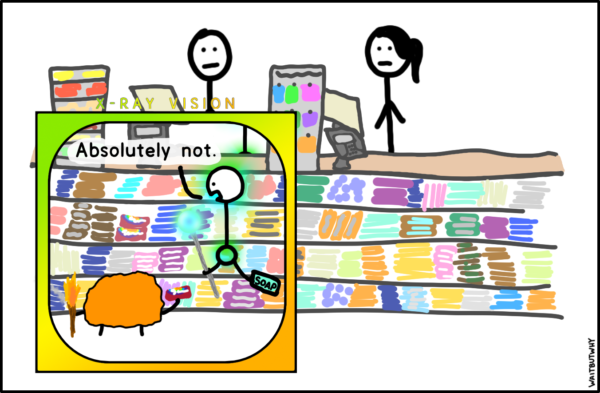
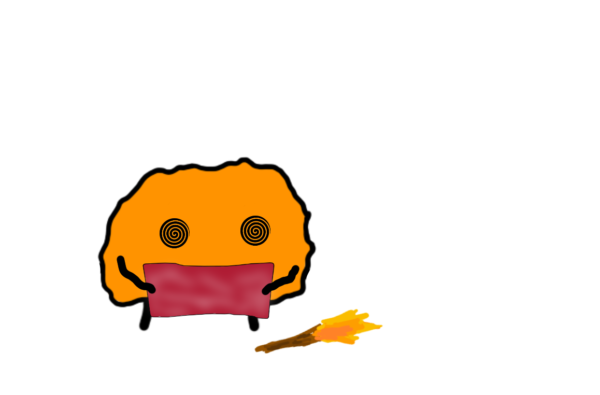
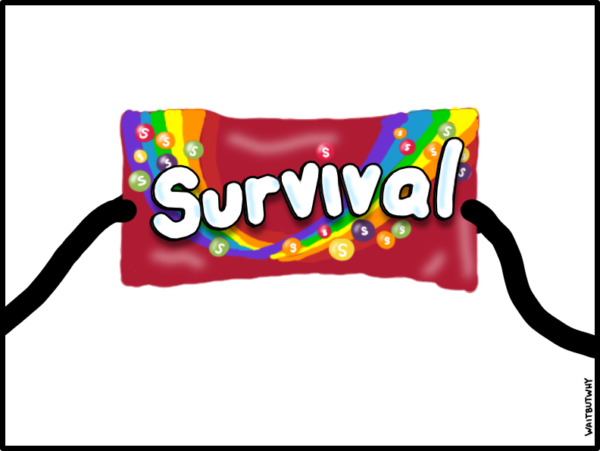
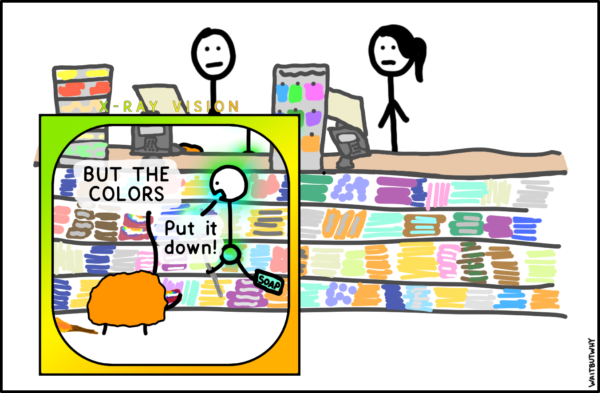
Seriously, this is hilarious stuff.
His writing is life changing. I’ve seen myself change how I approach debates and discussions now. If I react sharply or emotionally, I ask myself – hey, was that my Primitive Mind speaking? Let’s try to go back to the Higher Mind here.
Tim’s work is essential reading. For ALL humans. I’m surprised he’s not recommended reading in schools and colleges … ok, perhaps the occasional swearing doesn’t help!
But if that doesn’t bother you (and why should it), make sure to line up this story series, which has a couple more chapters to come, in your reading list.
Podcast episode/s of the week
a. Tim Ferriss with Tim Urban
More Tim Urban goodness here! In this conversation, Ferriss (who apart from being a super-achiever, happens to be a brilliant interviewer) quizzes Urban about his craft.
In it I found a powerful example of persistent questioning. Ferriss wants to know why Urban started the ‘Wait But Why’ blog. Note how he doesn’t give up till get gets an answer (emphasis mine):
Tim Ferriss: Why did you create ‘Wait But Why’? And where does the name come from?
Tim Urban: Yeah. So, I was able to kind of hone my voice writing 300 blog posts. I look back at the early ones, and I wince at the tones I was using. So, 300 blog posts will teach you the voice you like to write in. And so, that’s one thing. And then, towards the end, I decided one night to try to draw something. And I kind of said let me – I was going to try to depict this concept of it was funny when somebody – it was like doppelganger day on Facebook, and somebody posts a doppelganger that’s way better looking than they are, I always think that’s kind of hilarious. And I was like I’m going to draw a stick figure that’s kind of messy and then a handsome stick figure with a wave of hair.
And so, I did that. And it hit me that I was like that would be better in the drawing. And I realized I liked that. And so, I discovered that there, too. And so, when I started Wait But Why a couple of years –
Tim Ferriss: Did other people also respond positively to that? Or did you just –
Tim Urban: Very, yeah. It got great feedback, and then, I started just every post, it was like the last seven posts on the blog, all had drawings. And it was like I had discovered it at the very end. So, then, it was time to start a new project.
Tim Ferriss: Why was it time to start a new project? Why not continue writing about the Chicken McNuggets? No, I’m not trying to be a dick.
Tim Urban: No, it’s fair. And I also write about chicken nuggets sometimes.
Tim Ferriss: Sorry, family programming, not sure, sorry. Continue.
Tim Urban: No. It was time in my life, in general, to turn all of my attention, not a third of my attention, to one creative project. It was always I’m doing something with my full time, and then, I’m doing these two creative projects on the side.
Tim Ferriss: I’m going to be a pain the ass. I apologize, but that’s my nature. Why was it time? What realization or conversation or getting fired or whatever catalyzed the decision it’s time for me to put all of my eggs in one basket creatively?
Tim Urban: This thing you do makes me love your podcast. But it’s stressful being the person.
And then Tim Urban goes deeper into why he really wanted to go all-in on the ‘Wait But Why’ blog.
This conversation was recorded live in front of an audience and published in early 2018. Amidst all the camaraderie, fun and laughter, Urban does a deep dive into his research, thinking and writing process. It is gold if you want to improve on those fronts.
b. The Seen and the Unseen: Amit Varma with Pramit Bhattacharya
Data is the bedrock of decisions and few folks understand India’s data/statistics landscape like the Pramit Bhattacharya (who till recently was the Editor-Data at Mint).
He gives superb context as to why India was regarded as a pioneer in statistical surveys (among all countries, including developed ones) in the post-independence era, because of luminaries like PC Mahalanobis… and how that legacy is in bad shape now.
Articles of the week
a. The Three Sides of Risk by Morgan Housel
In this gripping read, Morgan shares a personal story – albeit a tragic one. It’s about managing risks and being humble in the face of probability.
Three friends go skiing down a steep and dangerous mountain slope and things don’t end well for some of them. You know what’s likely to come but you cannot take your attention away from the page.
b. R Ashwin interview by Sid Monga in the Cricket Monthly
Sid Monga is among our finest cricket writers. In this striking conversation with an all-time great, Monga gets Ashwin to talk about some of his most challenging periods as a sportsperson.
Cricket in India may seem glamorous from the outside, but reading this interview, you get the sense of the pains and sacrifices a sportsman has to make to succeed.
I was also struck by the amount of prep elite athletes put into their work:
Monga: Then when you go into Australia, Steve Smith, what are your plans?
Ashwin: I made him my obsession for about six months, not just two weeks or three weeks. Just footage, just watching different matches. The most recent series they played [before India toured Australia in 2020-21] was New Zealand. I went through every single day’s play. I would go on my app and check – how many runs was [Marnus] Labuschagne batting on when Will Somerville came on to bowl? Which ball did he hit over cow corner?
What do we look forward to doing on the weekend? Watching movies, eating out, shopping… All good fun.
But imagine if you won a lottery and got $100M in the bank. After taking care of family, friends, charity etc., what would you do? Would you end up spending the rest of your life in a never-ending Netflix-Zomato-holiday spiral? Not really…
Jason (podcaster, writer) calls these as ‘Type-1 fun’. Good for sometime.
What can be more interesting is Type-2 Fun:
“Type 2 fun is miserable while it’s happening, but fun in retrospect.”
On a lighter note, this reminded me of Calvin’s dad’s epic ‘character building’ strips

Tweet/s of the week
(Thats right – I’m adding a new section called ‘Tweets’!)
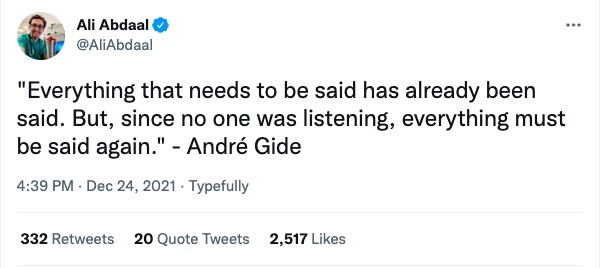
This is so true! Do not fret if you were not the original one to come up with the idea. Put your own spin to it and figure out distribution.
Quote of the week
(That’s right – also adding a section for insightful quotes that I came across!)
“The only ism that can take you closer to the truth is scepticism.”
– From Amit Verma’s introduction to the Pramit Bhattacharya episode
Video
a. ‘This video will make you angry’ by CGP Grey (6:36)
This video was referenced in Tim Urban’s blog post series. It’s made in 2015, and presciently uses the analogy of a virus to explain how ideas spread. One key element that makes us hit the forward button: the right emotions.
That’s it folks: my recommended reads, listens and views for the month.
Photo by Ross Findon on Unsplash








